Coca-Cola's ENCOKE: Brand Development and Marketing Plan in India
VerifiedAdded on 2023/06/09
|29
|7763
|348
Report
AI Summary
This report outlines Coca-Cola's brand development strategy for launching its new energy drink, ENCOKE, in the Indian market. It begins with an executive summary and introduction, highlighting Coca-Cola's global presence and its intent to penetrate the growing Indian energy drink market. The report details the positioning strategy, target market (focusing on young, middle-class Indians), and competitor analysis, primarily focusing on Red Bull. It further explores Points of Parity (POP) and Points of Difference (POD) for ENCOKE, emphasizing local manufacturing and unique flavors. The report also covers building brand equity through awareness and image, brand elements (name, logo, URL, slogan), brand associations, and a brand mantra. A comprehensive communication strategy, including message and creative strategy, media mix, and pricing strategy, is presented. The report also discusses methods for measuring brand equity, including qualitative and quantitative approaches, followed by a 12-month timeline for the product launch and recommendations for successful market entry. The provided assignment is available on Desklib, a platform offering a variety of study tools and resources for students.
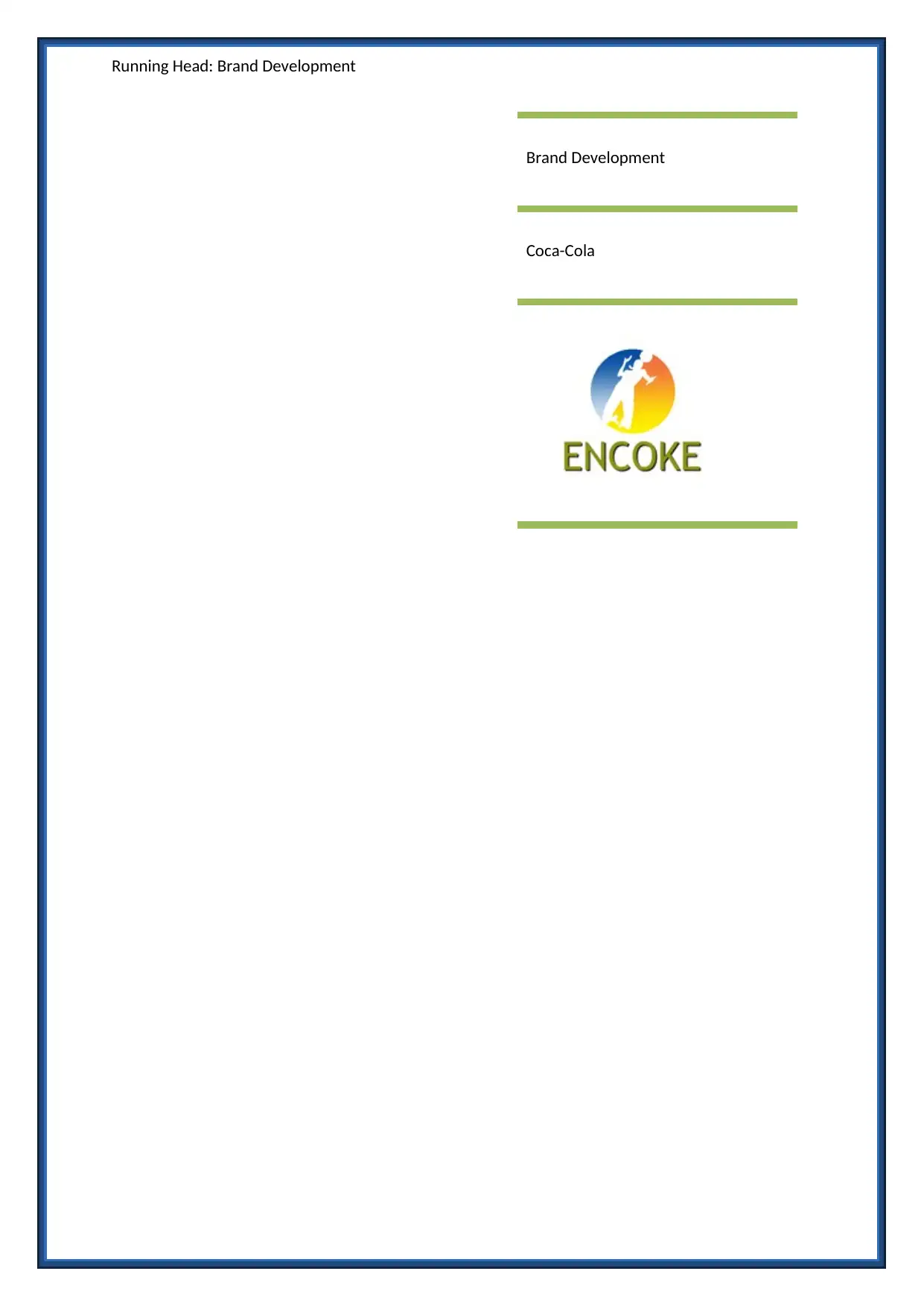
Running Head: Brand Development
Brand Development
Coca-Cola
Brand Development
Coca-Cola
Paraphrase This Document
Need a fresh take? Get an instant paraphrase of this document with our AI Paraphraser
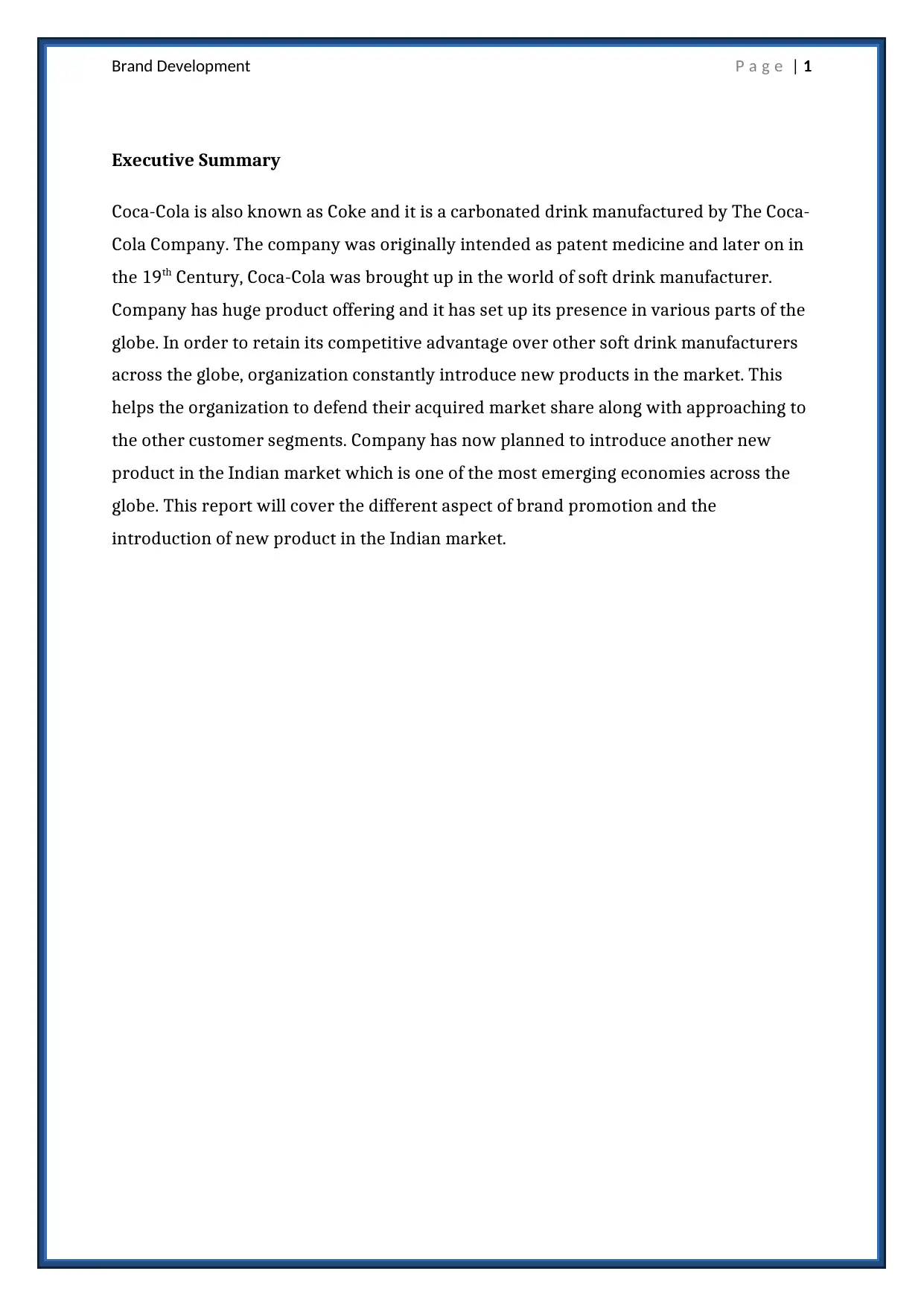
Brand Development P a g e | 1
Executive Summary
Coca-Cola is also known as Coke and it is a carbonated drink manufactured by The Coca-
Cola Company. The company was originally intended as patent medicine and later on in
the 19th Century, Coca-Cola was brought up in the world of soft drink manufacturer.
Company has huge product offering and it has set up its presence in various parts of the
globe. In order to retain its competitive advantage over other soft drink manufacturers
across the globe, organization constantly introduce new products in the market. This
helps the organization to defend their acquired market share along with approaching to
the other customer segments. Company has now planned to introduce another new
product in the Indian market which is one of the most emerging economies across the
globe. This report will cover the different aspect of brand promotion and the
introduction of new product in the Indian market.
Executive Summary
Coca-Cola is also known as Coke and it is a carbonated drink manufactured by The Coca-
Cola Company. The company was originally intended as patent medicine and later on in
the 19th Century, Coca-Cola was brought up in the world of soft drink manufacturer.
Company has huge product offering and it has set up its presence in various parts of the
globe. In order to retain its competitive advantage over other soft drink manufacturers
across the globe, organization constantly introduce new products in the market. This
helps the organization to defend their acquired market share along with approaching to
the other customer segments. Company has now planned to introduce another new
product in the Indian market which is one of the most emerging economies across the
globe. This report will cover the different aspect of brand promotion and the
introduction of new product in the Indian market.
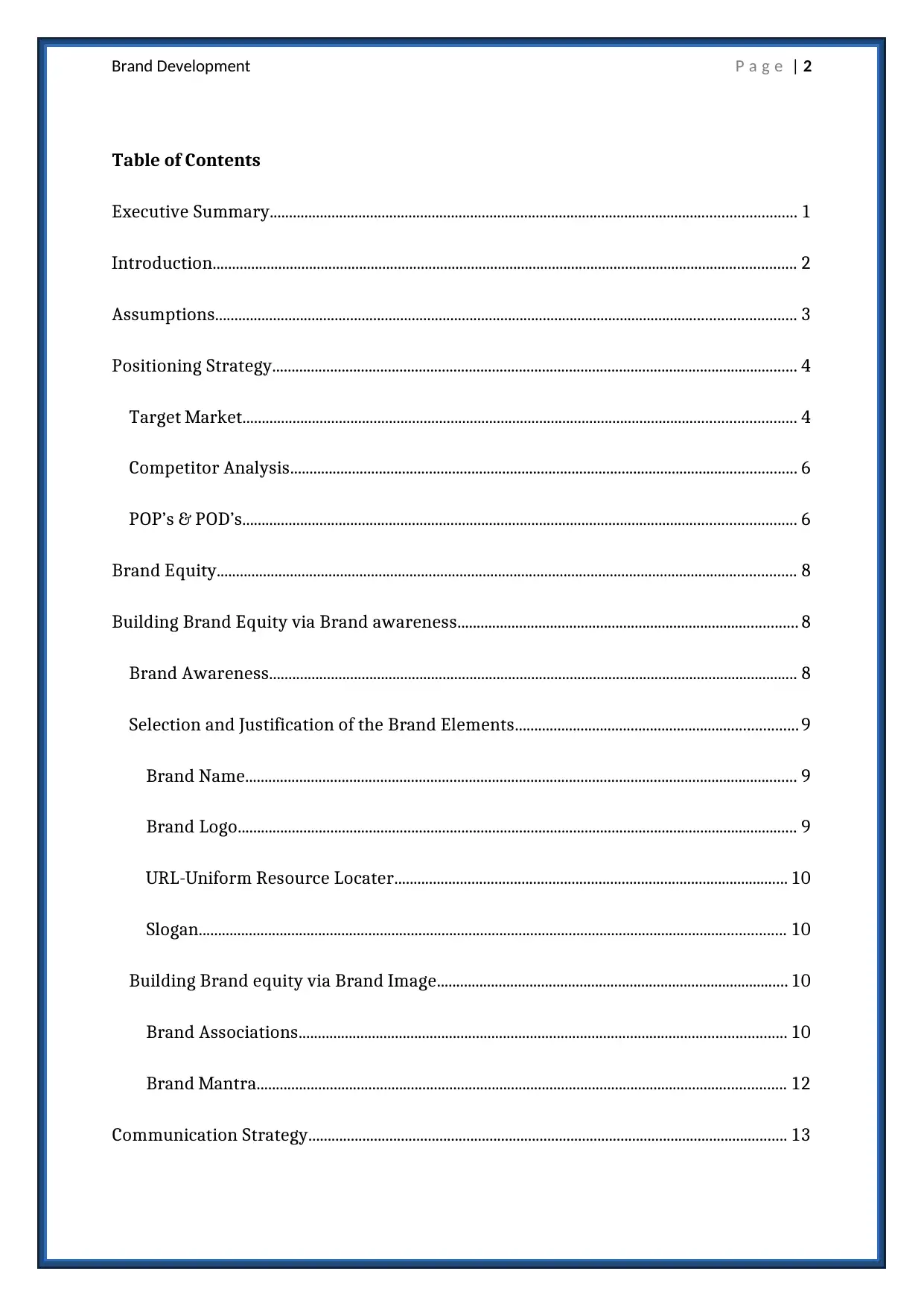
Brand Development P a g e | 2
Table of Contents
Executive Summary........................................................................................................................................ 1
Introduction....................................................................................................................................................... 2
Assumptions...................................................................................................................................................... 3
Positioning Strategy........................................................................................................................................ 4
Target Market............................................................................................................................................... 4
Competitor Analysis................................................................................................................................... 6
POP’s & POD’s............................................................................................................................................... 6
Brand Equity...................................................................................................................................................... 8
Building Brand Equity via Brand awareness........................................................................................ 8
Brand Awareness......................................................................................................................................... 8
Selection and Justification of the Brand Elements.........................................................................9
Brand Name............................................................................................................................................... 9
Brand Logo................................................................................................................................................. 9
URL-Uniform Resource Locater...................................................................................................... 10
Slogan........................................................................................................................................................ 10
Building Brand equity via Brand Image........................................................................................... 10
Brand Associations.............................................................................................................................. 10
Brand Mantra......................................................................................................................................... 12
Communication Strategy............................................................................................................................ 13
Table of Contents
Executive Summary........................................................................................................................................ 1
Introduction....................................................................................................................................................... 2
Assumptions...................................................................................................................................................... 3
Positioning Strategy........................................................................................................................................ 4
Target Market............................................................................................................................................... 4
Competitor Analysis................................................................................................................................... 6
POP’s & POD’s............................................................................................................................................... 6
Brand Equity...................................................................................................................................................... 8
Building Brand Equity via Brand awareness........................................................................................ 8
Brand Awareness......................................................................................................................................... 8
Selection and Justification of the Brand Elements.........................................................................9
Brand Name............................................................................................................................................... 9
Brand Logo................................................................................................................................................. 9
URL-Uniform Resource Locater...................................................................................................... 10
Slogan........................................................................................................................................................ 10
Building Brand equity via Brand Image........................................................................................... 10
Brand Associations.............................................................................................................................. 10
Brand Mantra......................................................................................................................................... 12
Communication Strategy............................................................................................................................ 13
⊘ This is a preview!⊘
Do you want full access?
Subscribe today to unlock all pages.

Trusted by 1+ million students worldwide
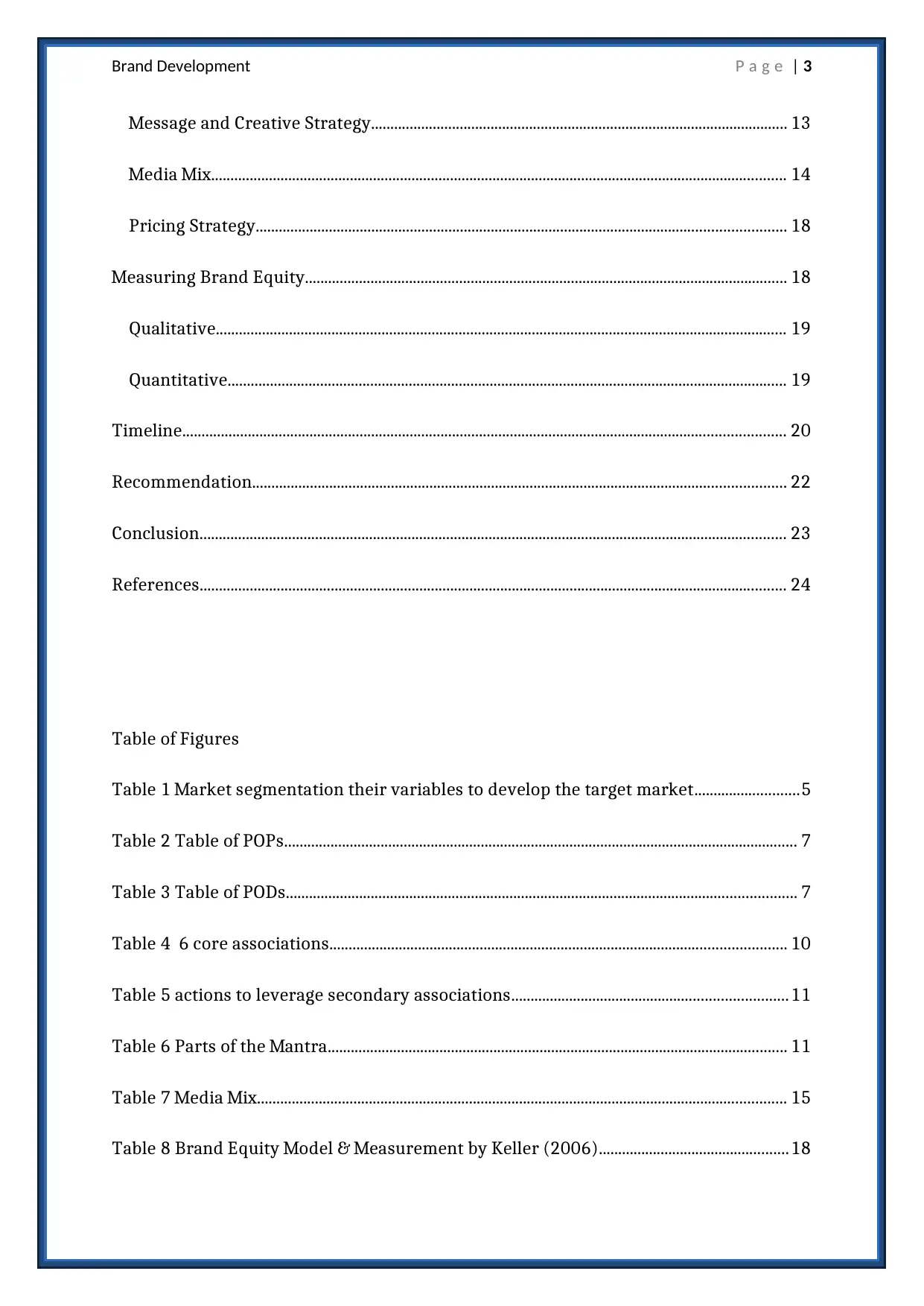
Brand Development P a g e | 3
Message and Creative Strategy............................................................................................................ 13
Media Mix..................................................................................................................................................... 14
Pricing Strategy......................................................................................................................................... 18
Measuring Brand Equity............................................................................................................................. 18
Qualitative.................................................................................................................................................... 19
Quantitative................................................................................................................................................. 19
Timeline............................................................................................................................................................ 20
Recommendation.......................................................................................................................................... 22
Conclusion........................................................................................................................................................ 23
References........................................................................................................................................................ 24
Table of Figures
Table 1 Market segmentation their variables to develop the target market...........................5
Table 2 Table of POPs..................................................................................................................................... 7
Table 3 Table of PODs.................................................................................................................................... 7
Table 4 6 core associations...................................................................................................................... 10
Table 5 actions to leverage secondary associations.......................................................................11
Table 6 Parts of the Mantra....................................................................................................................... 11
Table 7 Media Mix......................................................................................................................................... 15
Table 8 Brand Equity Model & Measurement by Keller (2006).................................................18
Message and Creative Strategy............................................................................................................ 13
Media Mix..................................................................................................................................................... 14
Pricing Strategy......................................................................................................................................... 18
Measuring Brand Equity............................................................................................................................. 18
Qualitative.................................................................................................................................................... 19
Quantitative................................................................................................................................................. 19
Timeline............................................................................................................................................................ 20
Recommendation.......................................................................................................................................... 22
Conclusion........................................................................................................................................................ 23
References........................................................................................................................................................ 24
Table of Figures
Table 1 Market segmentation their variables to develop the target market...........................5
Table 2 Table of POPs..................................................................................................................................... 7
Table 3 Table of PODs.................................................................................................................................... 7
Table 4 6 core associations...................................................................................................................... 10
Table 5 actions to leverage secondary associations.......................................................................11
Table 6 Parts of the Mantra....................................................................................................................... 11
Table 7 Media Mix......................................................................................................................................... 15
Table 8 Brand Equity Model & Measurement by Keller (2006).................................................18
Paraphrase This Document
Need a fresh take? Get an instant paraphrase of this document with our AI Paraphraser
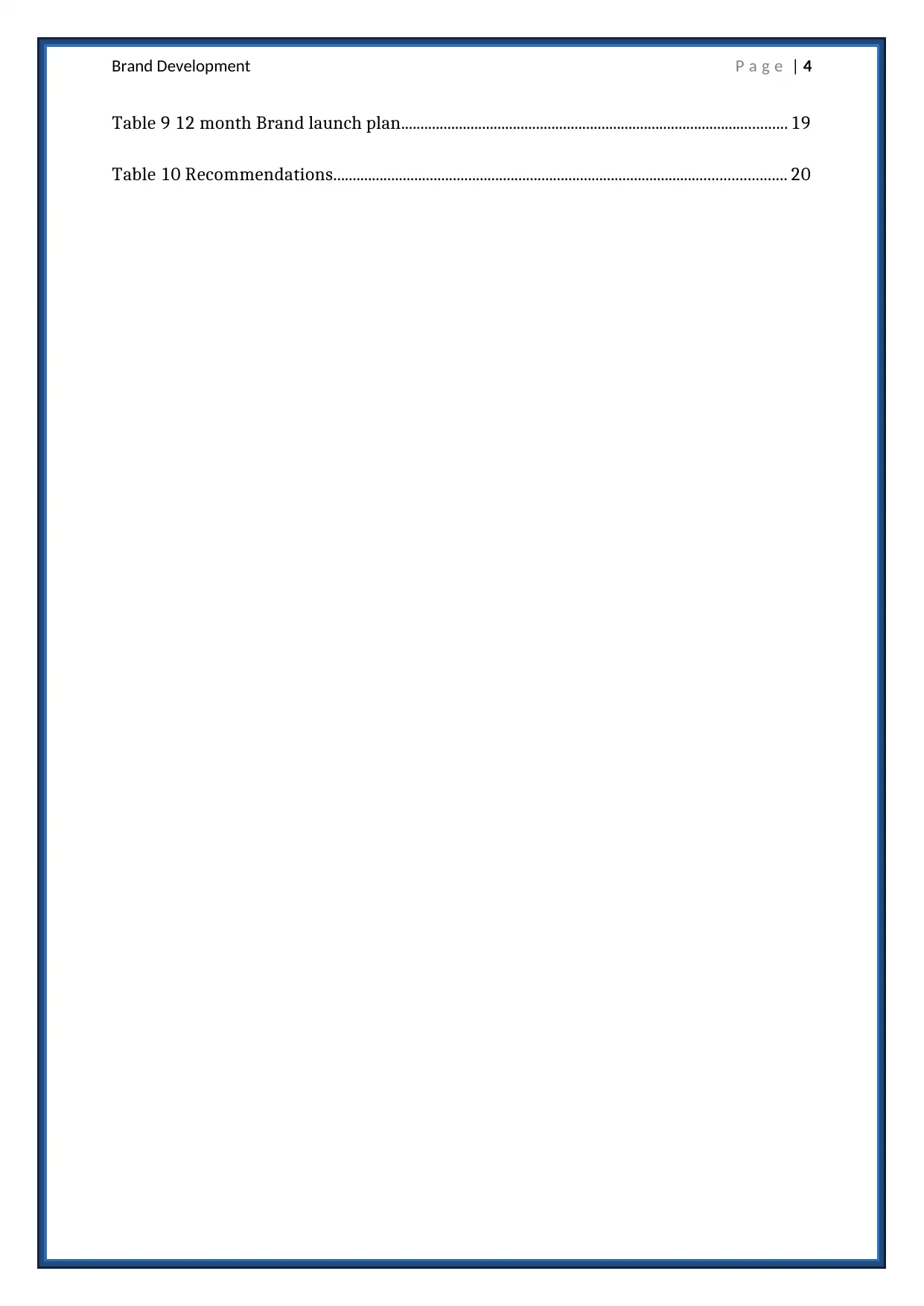
Brand Development P a g e | 4
Table 9 12 month Brand launch plan.................................................................................................... 19
Table 10 Recommendations..................................................................................................................... 20
Table 9 12 month Brand launch plan.................................................................................................... 19
Table 10 Recommendations..................................................................................................................... 20
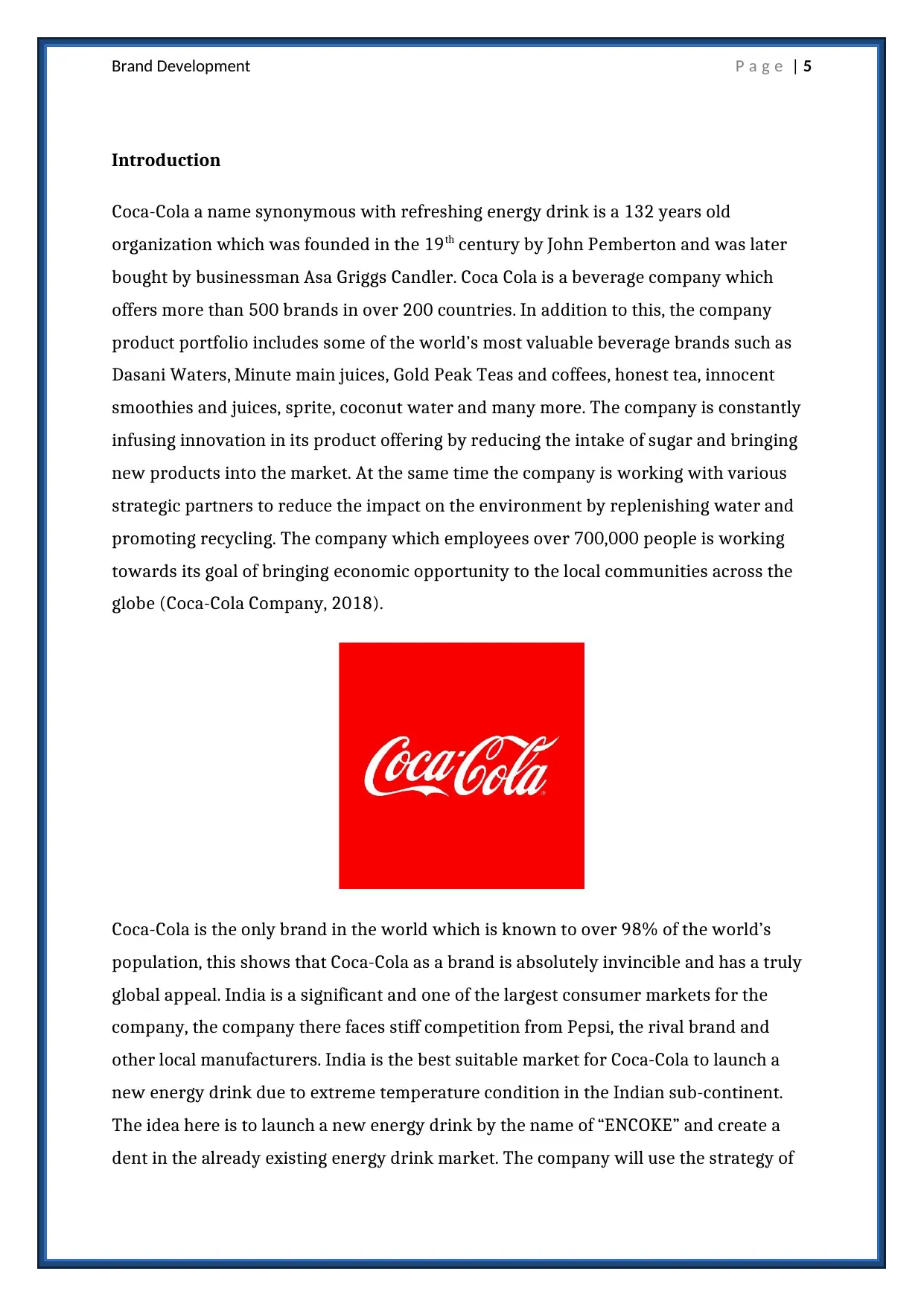
Brand Development P a g e | 5
Introduction
Coca-Cola a name synonymous with refreshing energy drink is a 132 years old
organization which was founded in the 19th century by John Pemberton and was later
bought by businessman Asa Griggs Candler. Coca Cola is a beverage company which
offers more than 500 brands in over 200 countries. In addition to this, the company
product portfolio includes some of the world’s most valuable beverage brands such as
Dasani Waters, Minute main juices, Gold Peak Teas and coffees, honest tea, innocent
smoothies and juices, sprite, coconut water and many more. The company is constantly
infusing innovation in its product offering by reducing the intake of sugar and bringing
new products into the market. At the same time the company is working with various
strategic partners to reduce the impact on the environment by replenishing water and
promoting recycling. The company which employees over 700,000 people is working
towards its goal of bringing economic opportunity to the local communities across the
globe (Coca-Cola Company, 2018).
Coca-Cola is the only brand in the world which is known to over 98% of the world’s
population, this shows that Coca-Cola as a brand is absolutely invincible and has a truly
global appeal. India is a significant and one of the largest consumer markets for the
company, the company there faces stiff competition from Pepsi, the rival brand and
other local manufacturers. India is the best suitable market for Coca-Cola to launch a
new energy drink due to extreme temperature condition in the Indian sub-continent.
The idea here is to launch a new energy drink by the name of “ENCOKE” and create a
dent in the already existing energy drink market. The company will use the strategy of
Introduction
Coca-Cola a name synonymous with refreshing energy drink is a 132 years old
organization which was founded in the 19th century by John Pemberton and was later
bought by businessman Asa Griggs Candler. Coca Cola is a beverage company which
offers more than 500 brands in over 200 countries. In addition to this, the company
product portfolio includes some of the world’s most valuable beverage brands such as
Dasani Waters, Minute main juices, Gold Peak Teas and coffees, honest tea, innocent
smoothies and juices, sprite, coconut water and many more. The company is constantly
infusing innovation in its product offering by reducing the intake of sugar and bringing
new products into the market. At the same time the company is working with various
strategic partners to reduce the impact on the environment by replenishing water and
promoting recycling. The company which employees over 700,000 people is working
towards its goal of bringing economic opportunity to the local communities across the
globe (Coca-Cola Company, 2018).
Coca-Cola is the only brand in the world which is known to over 98% of the world’s
population, this shows that Coca-Cola as a brand is absolutely invincible and has a truly
global appeal. India is a significant and one of the largest consumer markets for the
company, the company there faces stiff competition from Pepsi, the rival brand and
other local manufacturers. India is the best suitable market for Coca-Cola to launch a
new energy drink due to extreme temperature condition in the Indian sub-continent.
The idea here is to launch a new energy drink by the name of “ENCOKE” and create a
dent in the already existing energy drink market. The company will use the strategy of
⊘ This is a preview!⊘
Do you want full access?
Subscribe today to unlock all pages.

Trusted by 1+ million students worldwide
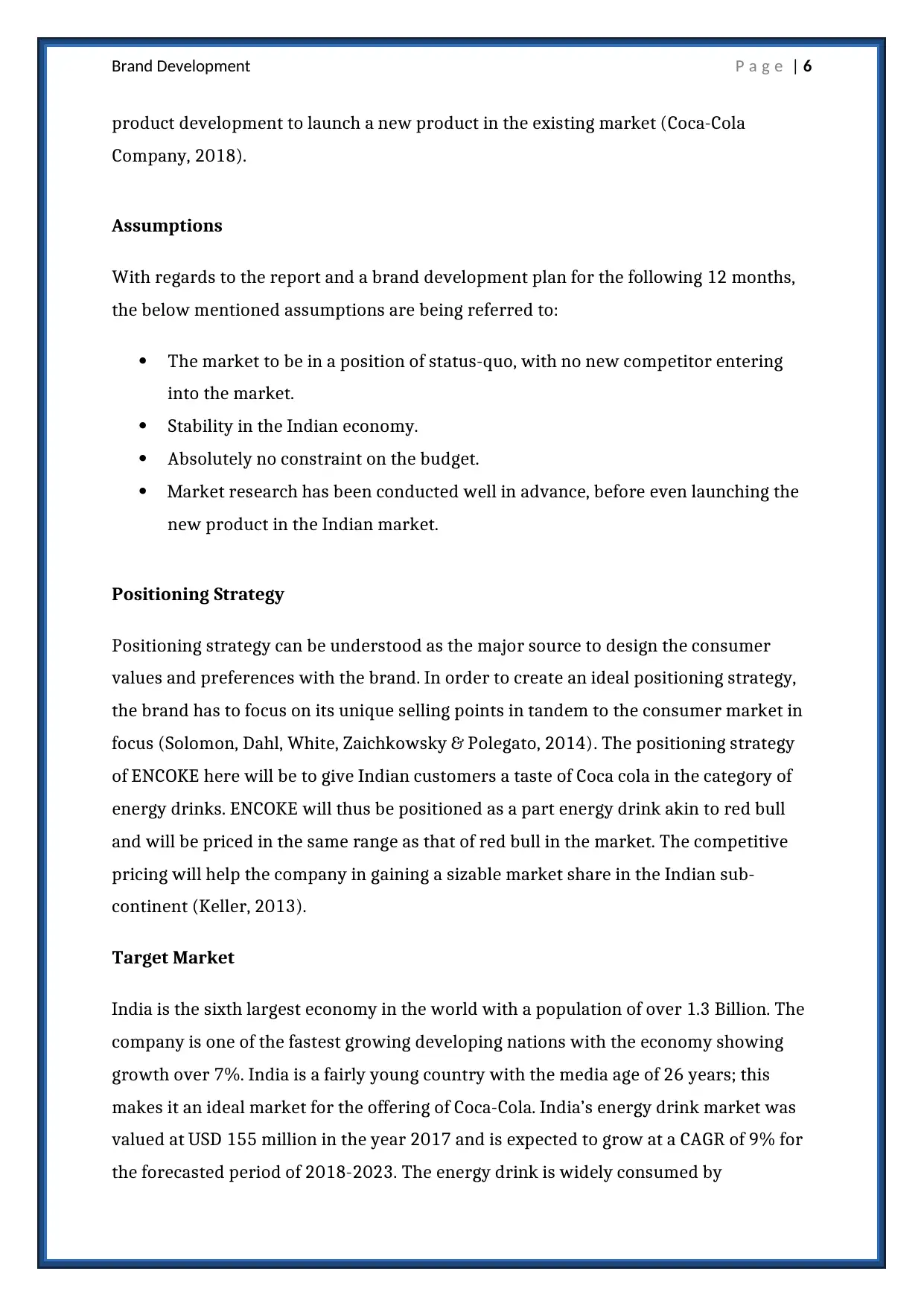
Brand Development P a g e | 6
product development to launch a new product in the existing market (Coca-Cola
Company, 2018).
Assumptions
With regards to the report and a brand development plan for the following 12 months,
the below mentioned assumptions are being referred to:
The market to be in a position of status-quo, with no new competitor entering
into the market.
Stability in the Indian economy.
Absolutely no constraint on the budget.
Market research has been conducted well in advance, before even launching the
new product in the Indian market.
Positioning Strategy
Positioning strategy can be understood as the major source to design the consumer
values and preferences with the brand. In order to create an ideal positioning strategy,
the brand has to focus on its unique selling points in tandem to the consumer market in
focus (Solomon, Dahl, White, Zaichkowsky & Polegato, 2014). The positioning strategy
of ENCOKE here will be to give Indian customers a taste of Coca cola in the category of
energy drinks. ENCOKE will thus be positioned as a part energy drink akin to red bull
and will be priced in the same range as that of red bull in the market. The competitive
pricing will help the company in gaining a sizable market share in the Indian sub-
continent (Keller, 2013).
Target Market
India is the sixth largest economy in the world with a population of over 1.3 Billion. The
company is one of the fastest growing developing nations with the economy showing
growth over 7%. India is a fairly young country with the media age of 26 years; this
makes it an ideal market for the offering of Coca-Cola. India’s energy drink market was
valued at USD 155 million in the year 2017 and is expected to grow at a CAGR of 9% for
the forecasted period of 2018-2023. The energy drink is widely consumed by
product development to launch a new product in the existing market (Coca-Cola
Company, 2018).
Assumptions
With regards to the report and a brand development plan for the following 12 months,
the below mentioned assumptions are being referred to:
The market to be in a position of status-quo, with no new competitor entering
into the market.
Stability in the Indian economy.
Absolutely no constraint on the budget.
Market research has been conducted well in advance, before even launching the
new product in the Indian market.
Positioning Strategy
Positioning strategy can be understood as the major source to design the consumer
values and preferences with the brand. In order to create an ideal positioning strategy,
the brand has to focus on its unique selling points in tandem to the consumer market in
focus (Solomon, Dahl, White, Zaichkowsky & Polegato, 2014). The positioning strategy
of ENCOKE here will be to give Indian customers a taste of Coca cola in the category of
energy drinks. ENCOKE will thus be positioned as a part energy drink akin to red bull
and will be priced in the same range as that of red bull in the market. The competitive
pricing will help the company in gaining a sizable market share in the Indian sub-
continent (Keller, 2013).
Target Market
India is the sixth largest economy in the world with a population of over 1.3 Billion. The
company is one of the fastest growing developing nations with the economy showing
growth over 7%. India is a fairly young country with the media age of 26 years; this
makes it an ideal market for the offering of Coca-Cola. India’s energy drink market was
valued at USD 155 million in the year 2017 and is expected to grow at a CAGR of 9% for
the forecasted period of 2018-2023. The energy drink is widely consumed by
Paraphrase This Document
Need a fresh take? Get an instant paraphrase of this document with our AI Paraphraser
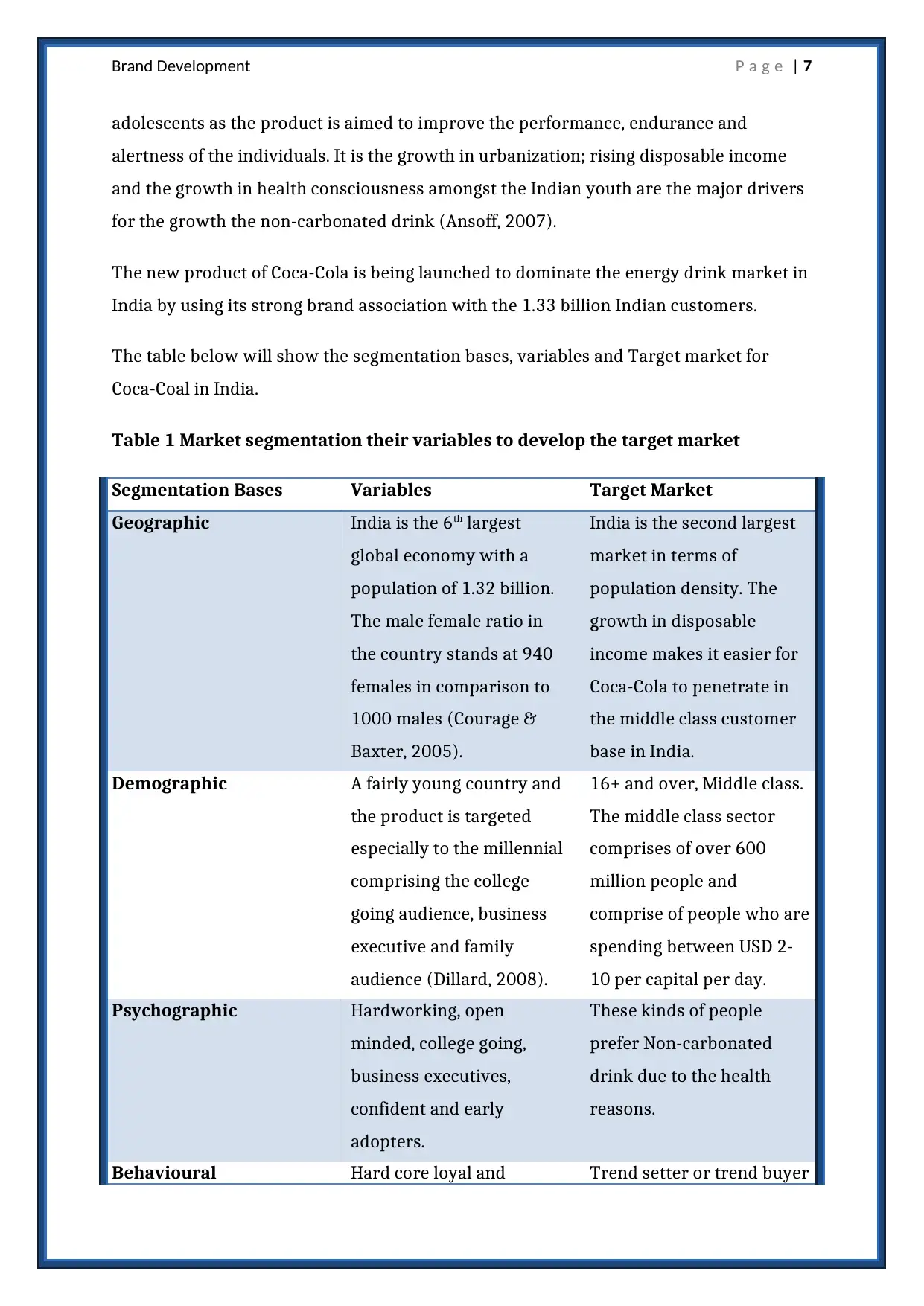
Brand Development P a g e | 7
adolescents as the product is aimed to improve the performance, endurance and
alertness of the individuals. It is the growth in urbanization; rising disposable income
and the growth in health consciousness amongst the Indian youth are the major drivers
for the growth the non-carbonated drink (Ansoff, 2007).
The new product of Coca-Cola is being launched to dominate the energy drink market in
India by using its strong brand association with the 1.33 billion Indian customers.
The table below will show the segmentation bases, variables and Target market for
Coca-Coal in India.
Table 1 Market segmentation their variables to develop the target market
Segmentation Bases Variables Target Market
Geographic India is the 6th largest
global economy with a
population of 1.32 billion.
The male female ratio in
the country stands at 940
females in comparison to
1000 males (Courage &
Baxter, 2005).
India is the second largest
market in terms of
population density. The
growth in disposable
income makes it easier for
Coca-Cola to penetrate in
the middle class customer
base in India.
Demographic A fairly young country and
the product is targeted
especially to the millennial
comprising the college
going audience, business
executive and family
audience (Dillard, 2008).
16+ and over, Middle class.
The middle class sector
comprises of over 600
million people and
comprise of people who are
spending between USD 2-
10 per capital per day.
Psychographic Hardworking, open
minded, college going,
business executives,
confident and early
adopters.
These kinds of people
prefer Non-carbonated
drink due to the health
reasons.
Behavioural Hard core loyal and Trend setter or trend buyer
adolescents as the product is aimed to improve the performance, endurance and
alertness of the individuals. It is the growth in urbanization; rising disposable income
and the growth in health consciousness amongst the Indian youth are the major drivers
for the growth the non-carbonated drink (Ansoff, 2007).
The new product of Coca-Cola is being launched to dominate the energy drink market in
India by using its strong brand association with the 1.33 billion Indian customers.
The table below will show the segmentation bases, variables and Target market for
Coca-Coal in India.
Table 1 Market segmentation their variables to develop the target market
Segmentation Bases Variables Target Market
Geographic India is the 6th largest
global economy with a
population of 1.32 billion.
The male female ratio in
the country stands at 940
females in comparison to
1000 males (Courage &
Baxter, 2005).
India is the second largest
market in terms of
population density. The
growth in disposable
income makes it easier for
Coca-Cola to penetrate in
the middle class customer
base in India.
Demographic A fairly young country and
the product is targeted
especially to the millennial
comprising the college
going audience, business
executive and family
audience (Dillard, 2008).
16+ and over, Middle class.
The middle class sector
comprises of over 600
million people and
comprise of people who are
spending between USD 2-
10 per capital per day.
Psychographic Hardworking, open
minded, college going,
business executives,
confident and early
adopters.
These kinds of people
prefer Non-carbonated
drink due to the health
reasons.
Behavioural Hard core loyal and Trend setter or trend buyer
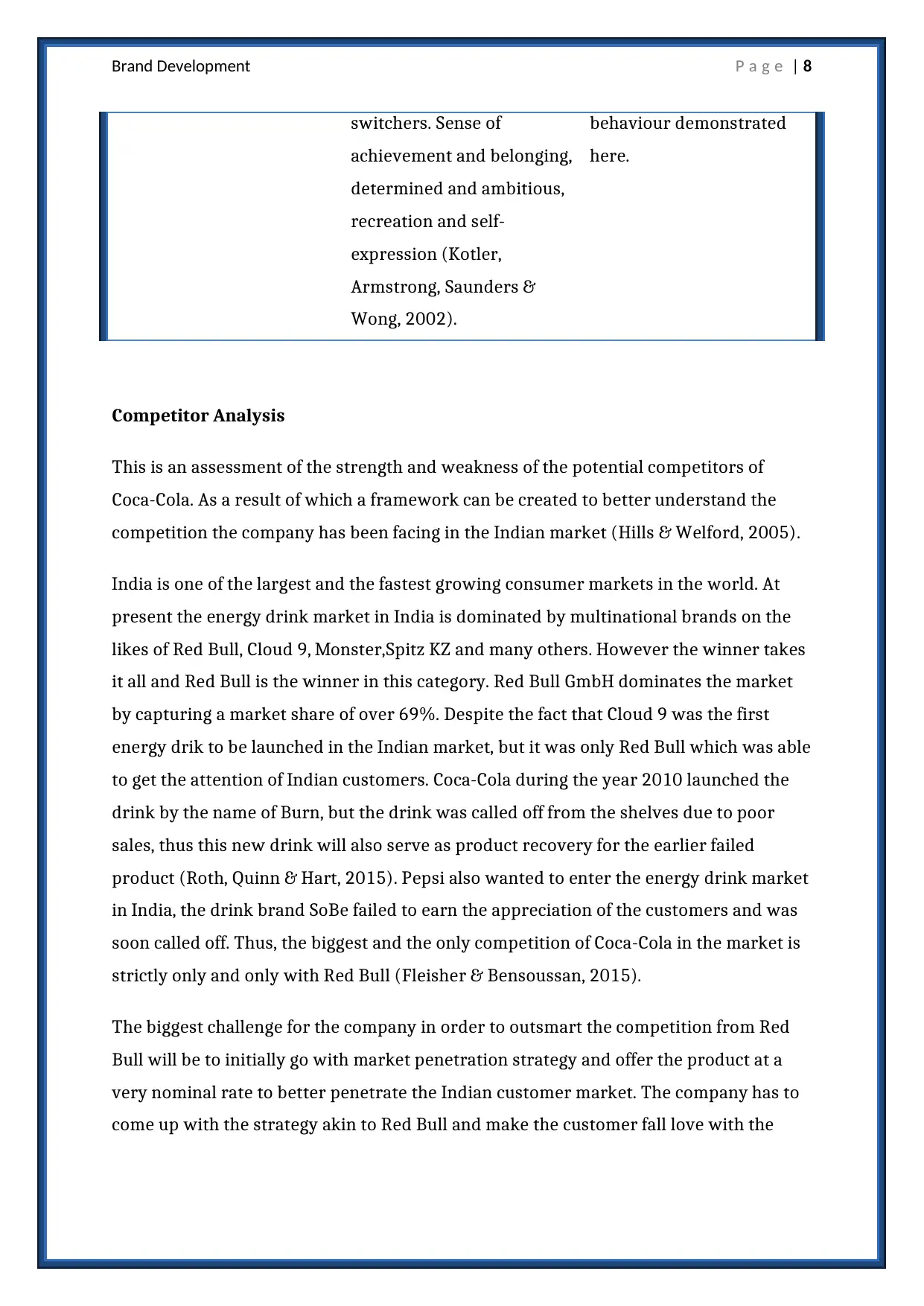
Brand Development P a g e | 8
switchers. Sense of
achievement and belonging,
determined and ambitious,
recreation and self-
expression (Kotler,
Armstrong, Saunders &
Wong, 2002).
behaviour demonstrated
here.
Competitor Analysis
This is an assessment of the strength and weakness of the potential competitors of
Coca-Cola. As a result of which a framework can be created to better understand the
competition the company has been facing in the Indian market (Hills & Welford, 2005).
India is one of the largest and the fastest growing consumer markets in the world. At
present the energy drink market in India is dominated by multinational brands on the
likes of Red Bull, Cloud 9, Monster,Spitz KZ and many others. However the winner takes
it all and Red Bull is the winner in this category. Red Bull GmbH dominates the market
by capturing a market share of over 69%. Despite the fact that Cloud 9 was the first
energy drik to be launched in the Indian market, but it was only Red Bull which was able
to get the attention of Indian customers. Coca-Cola during the year 2010 launched the
drink by the name of Burn, but the drink was called off from the shelves due to poor
sales, thus this new drink will also serve as product recovery for the earlier failed
product (Roth, Quinn & Hart, 2015). Pepsi also wanted to enter the energy drink market
in India, the drink brand SoBe failed to earn the appreciation of the customers and was
soon called off. Thus, the biggest and the only competition of Coca-Cola in the market is
strictly only and only with Red Bull (Fleisher & Bensoussan, 2015).
The biggest challenge for the company in order to outsmart the competition from Red
Bull will be to initially go with market penetration strategy and offer the product at a
very nominal rate to better penetrate the Indian customer market. The company has to
come up with the strategy akin to Red Bull and make the customer fall love with the
switchers. Sense of
achievement and belonging,
determined and ambitious,
recreation and self-
expression (Kotler,
Armstrong, Saunders &
Wong, 2002).
behaviour demonstrated
here.
Competitor Analysis
This is an assessment of the strength and weakness of the potential competitors of
Coca-Cola. As a result of which a framework can be created to better understand the
competition the company has been facing in the Indian market (Hills & Welford, 2005).
India is one of the largest and the fastest growing consumer markets in the world. At
present the energy drink market in India is dominated by multinational brands on the
likes of Red Bull, Cloud 9, Monster,Spitz KZ and many others. However the winner takes
it all and Red Bull is the winner in this category. Red Bull GmbH dominates the market
by capturing a market share of over 69%. Despite the fact that Cloud 9 was the first
energy drik to be launched in the Indian market, but it was only Red Bull which was able
to get the attention of Indian customers. Coca-Cola during the year 2010 launched the
drink by the name of Burn, but the drink was called off from the shelves due to poor
sales, thus this new drink will also serve as product recovery for the earlier failed
product (Roth, Quinn & Hart, 2015). Pepsi also wanted to enter the energy drink market
in India, the drink brand SoBe failed to earn the appreciation of the customers and was
soon called off. Thus, the biggest and the only competition of Coca-Cola in the market is
strictly only and only with Red Bull (Fleisher & Bensoussan, 2015).
The biggest challenge for the company in order to outsmart the competition from Red
Bull will be to initially go with market penetration strategy and offer the product at a
very nominal rate to better penetrate the Indian customer market. The company has to
come up with the strategy akin to Red Bull and make the customer fall love with the
⊘ This is a preview!⊘
Do you want full access?
Subscribe today to unlock all pages.

Trusted by 1+ million students worldwide
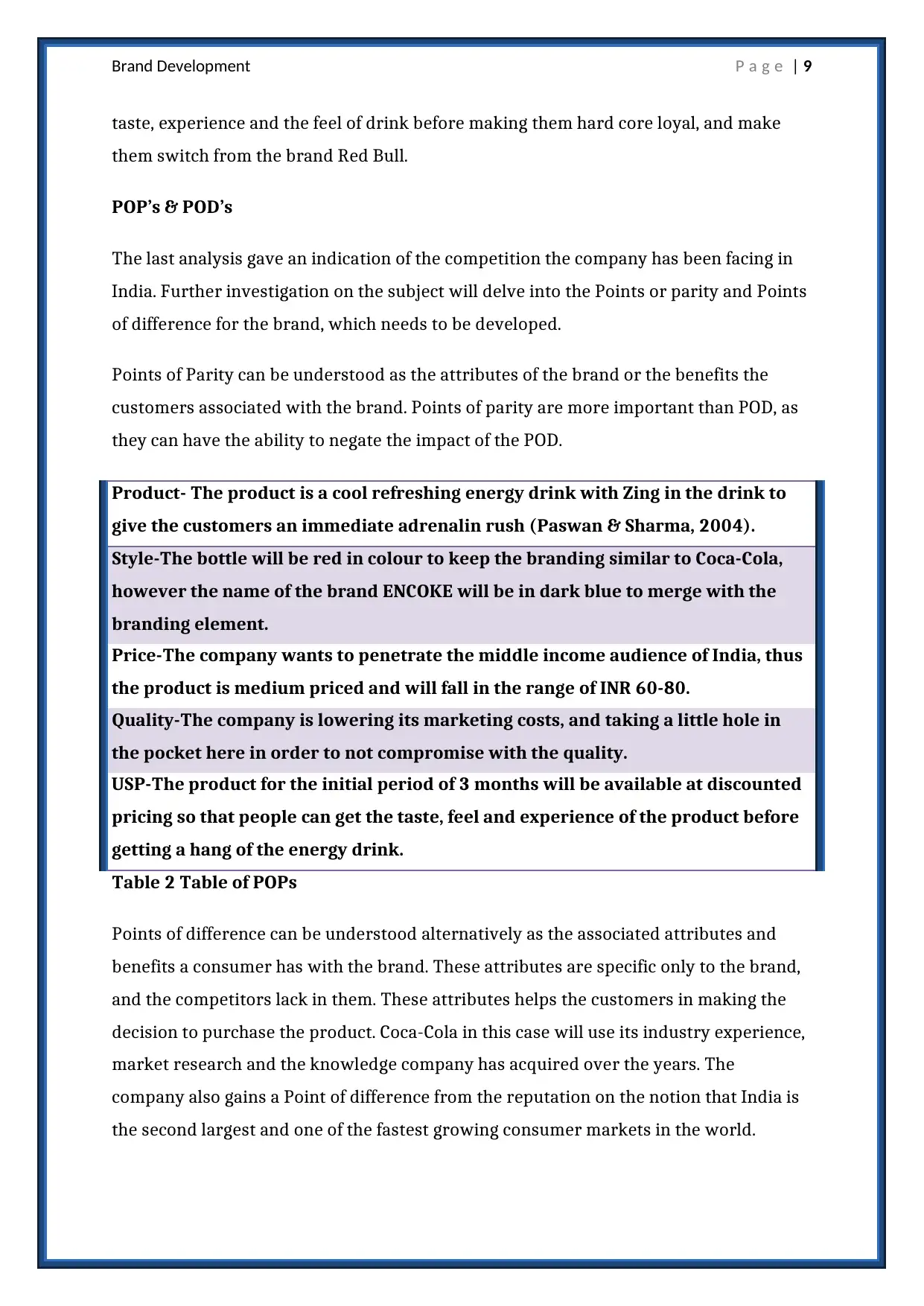
Brand Development P a g e | 9
taste, experience and the feel of drink before making them hard core loyal, and make
them switch from the brand Red Bull.
POP’s & POD’s
The last analysis gave an indication of the competition the company has been facing in
India. Further investigation on the subject will delve into the Points or parity and Points
of difference for the brand, which needs to be developed.
Points of Parity can be understood as the attributes of the brand or the benefits the
customers associated with the brand. Points of parity are more important than POD, as
they can have the ability to negate the impact of the POD.
Product- The product is a cool refreshing energy drink with Zing in the drink to
give the customers an immediate adrenalin rush (Paswan & Sharma, 2004).
Style-The bottle will be red in colour to keep the branding similar to Coca-Cola,
however the name of the brand ENCOKE will be in dark blue to merge with the
branding element.
Price-The company wants to penetrate the middle income audience of India, thus
the product is medium priced and will fall in the range of INR 60-80.
Quality-The company is lowering its marketing costs, and taking a little hole in
the pocket here in order to not compromise with the quality.
USP-The product for the initial period of 3 months will be available at discounted
pricing so that people can get the taste, feel and experience of the product before
getting a hang of the energy drink.
Table 2 Table of POPs
Points of difference can be understood alternatively as the associated attributes and
benefits a consumer has with the brand. These attributes are specific only to the brand,
and the competitors lack in them. These attributes helps the customers in making the
decision to purchase the product. Coca-Cola in this case will use its industry experience,
market research and the knowledge company has acquired over the years. The
company also gains a Point of difference from the reputation on the notion that India is
the second largest and one of the fastest growing consumer markets in the world.
taste, experience and the feel of drink before making them hard core loyal, and make
them switch from the brand Red Bull.
POP’s & POD’s
The last analysis gave an indication of the competition the company has been facing in
India. Further investigation on the subject will delve into the Points or parity and Points
of difference for the brand, which needs to be developed.
Points of Parity can be understood as the attributes of the brand or the benefits the
customers associated with the brand. Points of parity are more important than POD, as
they can have the ability to negate the impact of the POD.
Product- The product is a cool refreshing energy drink with Zing in the drink to
give the customers an immediate adrenalin rush (Paswan & Sharma, 2004).
Style-The bottle will be red in colour to keep the branding similar to Coca-Cola,
however the name of the brand ENCOKE will be in dark blue to merge with the
branding element.
Price-The company wants to penetrate the middle income audience of India, thus
the product is medium priced and will fall in the range of INR 60-80.
Quality-The company is lowering its marketing costs, and taking a little hole in
the pocket here in order to not compromise with the quality.
USP-The product for the initial period of 3 months will be available at discounted
pricing so that people can get the taste, feel and experience of the product before
getting a hang of the energy drink.
Table 2 Table of POPs
Points of difference can be understood alternatively as the associated attributes and
benefits a consumer has with the brand. These attributes are specific only to the brand,
and the competitors lack in them. These attributes helps the customers in making the
decision to purchase the product. Coca-Cola in this case will use its industry experience,
market research and the knowledge company has acquired over the years. The
company also gains a Point of difference from the reputation on the notion that India is
the second largest and one of the fastest growing consumer markets in the world.
Paraphrase This Document
Need a fresh take? Get an instant paraphrase of this document with our AI Paraphraser
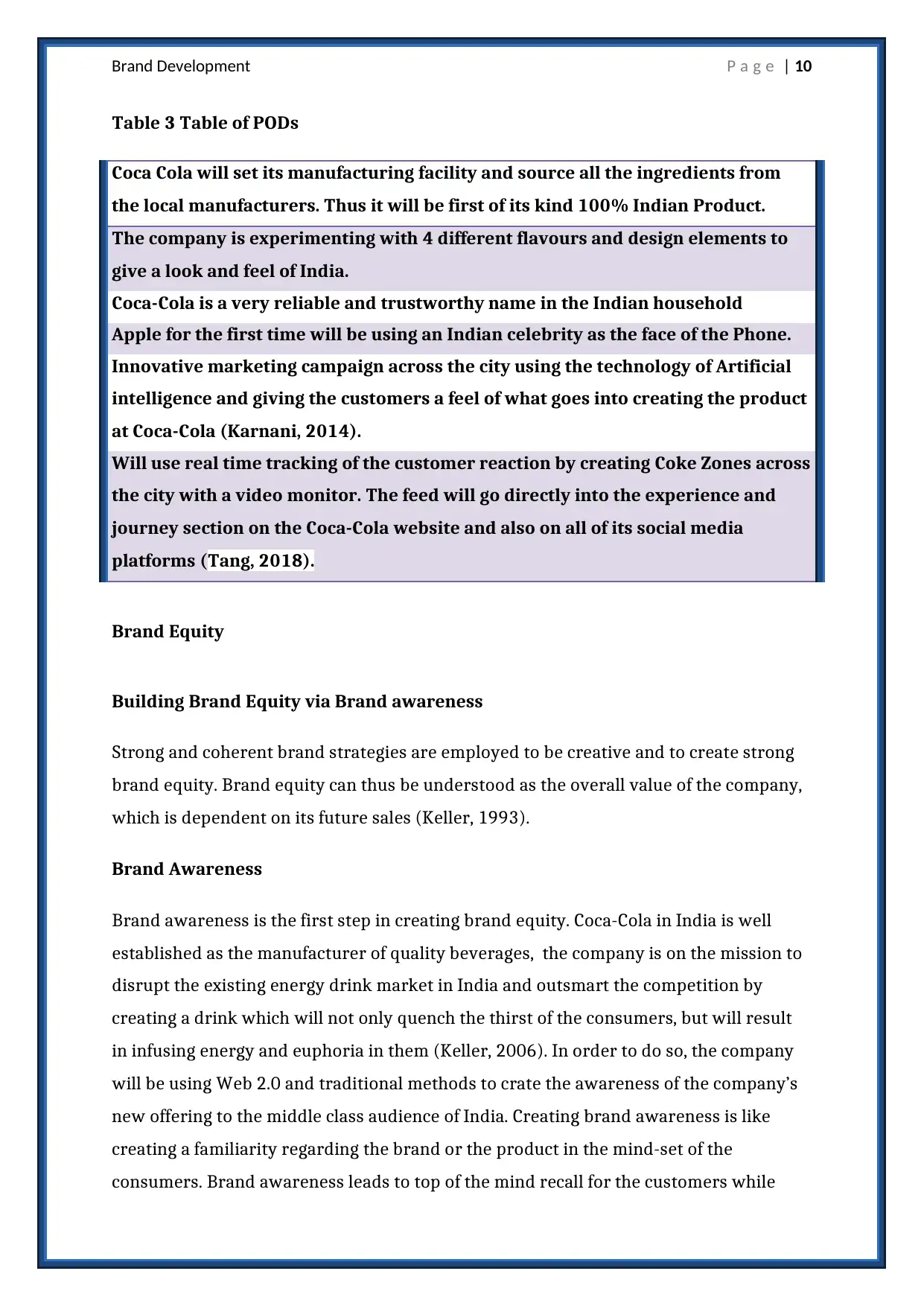
Brand Development P a g e | 10
Table 3 Table of PODs
Coca Cola will set its manufacturing facility and source all the ingredients from
the local manufacturers. Thus it will be first of its kind 100% Indian Product.
The company is experimenting with 4 different flavours and design elements to
give a look and feel of India.
Coca-Cola is a very reliable and trustworthy name in the Indian household
Apple for the first time will be using an Indian celebrity as the face of the Phone.
Innovative marketing campaign across the city using the technology of Artificial
intelligence and giving the customers a feel of what goes into creating the product
at Coca-Cola (Karnani, 2014).
Will use real time tracking of the customer reaction by creating Coke Zones across
the city with a video monitor. The feed will go directly into the experience and
journey section on the Coca-Cola website and also on all of its social media
platforms (Tang, 2018).
Brand Equity
Building Brand Equity via Brand awareness
Strong and coherent brand strategies are employed to be creative and to create strong
brand equity. Brand equity can thus be understood as the overall value of the company,
which is dependent on its future sales (Keller, 1993).
Brand Awareness
Brand awareness is the first step in creating brand equity. Coca-Cola in India is well
established as the manufacturer of quality beverages, the company is on the mission to
disrupt the existing energy drink market in India and outsmart the competition by
creating a drink which will not only quench the thirst of the consumers, but will result
in infusing energy and euphoria in them (Keller, 2006). In order to do so, the company
will be using Web 2.0 and traditional methods to crate the awareness of the company’s
new offering to the middle class audience of India. Creating brand awareness is like
creating a familiarity regarding the brand or the product in the mind-set of the
consumers. Brand awareness leads to top of the mind recall for the customers while
Table 3 Table of PODs
Coca Cola will set its manufacturing facility and source all the ingredients from
the local manufacturers. Thus it will be first of its kind 100% Indian Product.
The company is experimenting with 4 different flavours and design elements to
give a look and feel of India.
Coca-Cola is a very reliable and trustworthy name in the Indian household
Apple for the first time will be using an Indian celebrity as the face of the Phone.
Innovative marketing campaign across the city using the technology of Artificial
intelligence and giving the customers a feel of what goes into creating the product
at Coca-Cola (Karnani, 2014).
Will use real time tracking of the customer reaction by creating Coke Zones across
the city with a video monitor. The feed will go directly into the experience and
journey section on the Coca-Cola website and also on all of its social media
platforms (Tang, 2018).
Brand Equity
Building Brand Equity via Brand awareness
Strong and coherent brand strategies are employed to be creative and to create strong
brand equity. Brand equity can thus be understood as the overall value of the company,
which is dependent on its future sales (Keller, 1993).
Brand Awareness
Brand awareness is the first step in creating brand equity. Coca-Cola in India is well
established as the manufacturer of quality beverages, the company is on the mission to
disrupt the existing energy drink market in India and outsmart the competition by
creating a drink which will not only quench the thirst of the consumers, but will result
in infusing energy and euphoria in them (Keller, 2006). In order to do so, the company
will be using Web 2.0 and traditional methods to crate the awareness of the company’s
new offering to the middle class audience of India. Creating brand awareness is like
creating a familiarity regarding the brand or the product in the mind-set of the
consumers. Brand awareness leads to top of the mind recall for the customers while
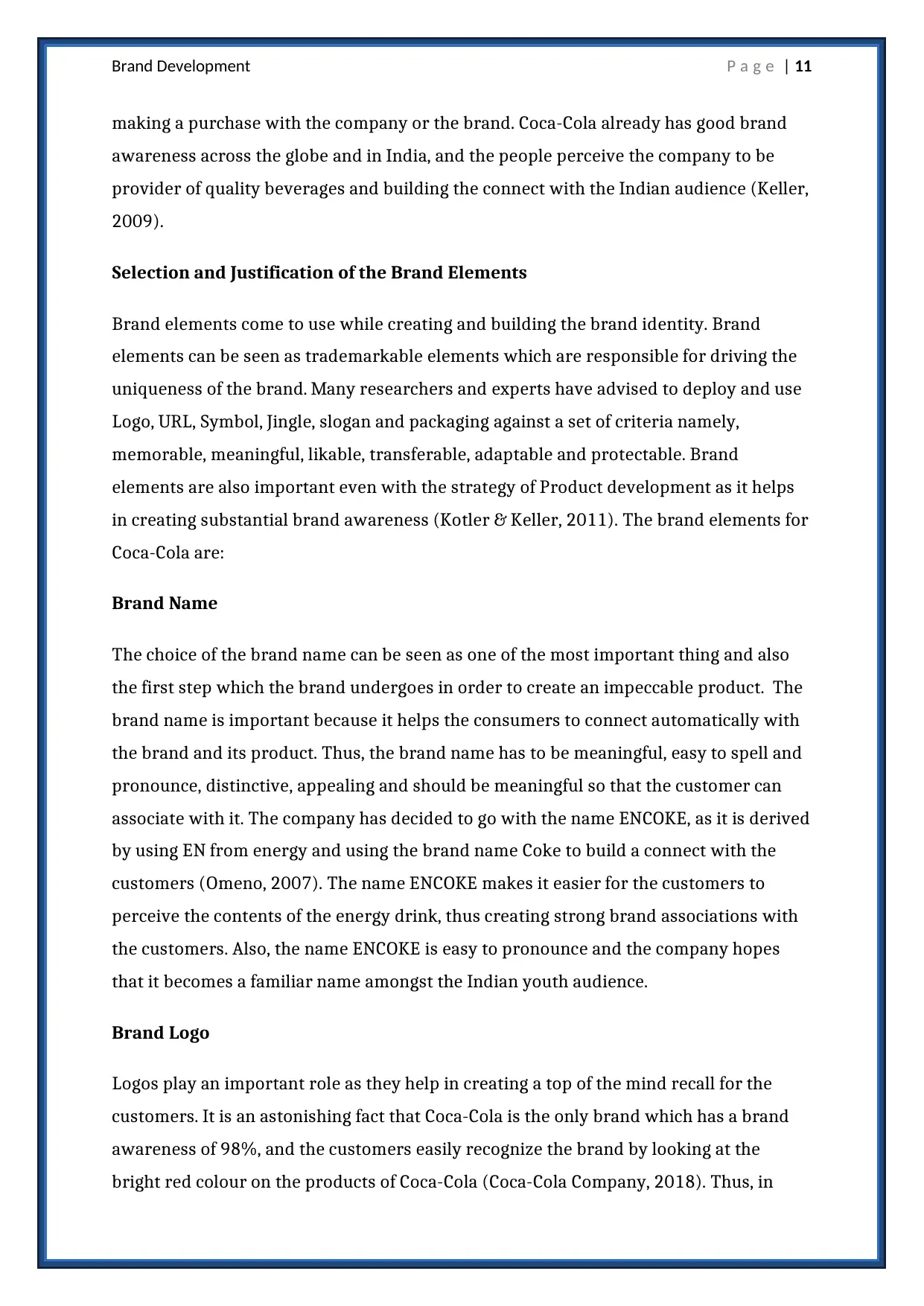
Brand Development P a g e | 11
making a purchase with the company or the brand. Coca-Cola already has good brand
awareness across the globe and in India, and the people perceive the company to be
provider of quality beverages and building the connect with the Indian audience (Keller,
2009).
Selection and Justification of the Brand Elements
Brand elements come to use while creating and building the brand identity. Brand
elements can be seen as trademarkable elements which are responsible for driving the
uniqueness of the brand. Many researchers and experts have advised to deploy and use
Logo, URL, Symbol, Jingle, slogan and packaging against a set of criteria namely,
memorable, meaningful, likable, transferable, adaptable and protectable. Brand
elements are also important even with the strategy of Product development as it helps
in creating substantial brand awareness (Kotler & Keller, 2011). The brand elements for
Coca-Cola are:
Brand Name
The choice of the brand name can be seen as one of the most important thing and also
the first step which the brand undergoes in order to create an impeccable product. The
brand name is important because it helps the consumers to connect automatically with
the brand and its product. Thus, the brand name has to be meaningful, easy to spell and
pronounce, distinctive, appealing and should be meaningful so that the customer can
associate with it. The company has decided to go with the name ENCOKE, as it is derived
by using EN from energy and using the brand name Coke to build a connect with the
customers (Omeno, 2007). The name ENCOKE makes it easier for the customers to
perceive the contents of the energy drink, thus creating strong brand associations with
the customers. Also, the name ENCOKE is easy to pronounce and the company hopes
that it becomes a familiar name amongst the Indian youth audience.
Brand Logo
Logos play an important role as they help in creating a top of the mind recall for the
customers. It is an astonishing fact that Coca-Cola is the only brand which has a brand
awareness of 98%, and the customers easily recognize the brand by looking at the
bright red colour on the products of Coca-Cola (Coca-Cola Company, 2018). Thus, in
making a purchase with the company or the brand. Coca-Cola already has good brand
awareness across the globe and in India, and the people perceive the company to be
provider of quality beverages and building the connect with the Indian audience (Keller,
2009).
Selection and Justification of the Brand Elements
Brand elements come to use while creating and building the brand identity. Brand
elements can be seen as trademarkable elements which are responsible for driving the
uniqueness of the brand. Many researchers and experts have advised to deploy and use
Logo, URL, Symbol, Jingle, slogan and packaging against a set of criteria namely,
memorable, meaningful, likable, transferable, adaptable and protectable. Brand
elements are also important even with the strategy of Product development as it helps
in creating substantial brand awareness (Kotler & Keller, 2011). The brand elements for
Coca-Cola are:
Brand Name
The choice of the brand name can be seen as one of the most important thing and also
the first step which the brand undergoes in order to create an impeccable product. The
brand name is important because it helps the consumers to connect automatically with
the brand and its product. Thus, the brand name has to be meaningful, easy to spell and
pronounce, distinctive, appealing and should be meaningful so that the customer can
associate with it. The company has decided to go with the name ENCOKE, as it is derived
by using EN from energy and using the brand name Coke to build a connect with the
customers (Omeno, 2007). The name ENCOKE makes it easier for the customers to
perceive the contents of the energy drink, thus creating strong brand associations with
the customers. Also, the name ENCOKE is easy to pronounce and the company hopes
that it becomes a familiar name amongst the Indian youth audience.
Brand Logo
Logos play an important role as they help in creating a top of the mind recall for the
customers. It is an astonishing fact that Coca-Cola is the only brand which has a brand
awareness of 98%, and the customers easily recognize the brand by looking at the
bright red colour on the products of Coca-Cola (Coca-Cola Company, 2018). Thus, in
⊘ This is a preview!⊘
Do you want full access?
Subscribe today to unlock all pages.

Trusted by 1+ million students worldwide
1 out of 29
Related Documents
Your All-in-One AI-Powered Toolkit for Academic Success.
+13062052269
info@desklib.com
Available 24*7 on WhatsApp / Email
![[object Object]](/_next/static/media/star-bottom.7253800d.svg)
Unlock your academic potential
Copyright © 2020–2025 A2Z Services. All Rights Reserved. Developed and managed by ZUCOL.





